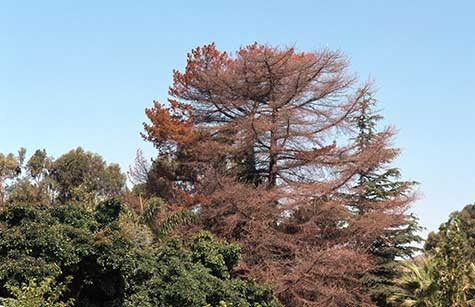[From the August 2015 issue of the UC IPM Green Bulletin]
Figure 1. Tree roots often grow near the surface when soil is compacted, or when the only water available comes from shallow irrigation.
California has a number of native bark beetle species that individually do only minor damage as they bore through the outer bark to reach the inner bark (phloem) and wood surface. Bark beetles are relatively small insects; most species are smaller than a grain of rice. When their population densities are low, these beetles typically attack only the most stressed pines. However, when their population densities are high, they attack and kill healthier trees (Figure 2). If drought conditions continue and beetle populations grow, the beetles can attack in numbers large enough to overwhelm tree defenses.
Figure 2. Monterey pine killed by bark beetles.
Deep-red fresh sap around open tunnels typically indicates that a more serious invasion is in progress. Severely stressed trees cannot fight back, and may produce little or no sap at all. Instead, all you may find are piles of frass in the bark fissures or on the ground. Regardless of whether the tree is defending itself or not, little can be done to stop an infestation once the beetles are in the tree.
Figure 3. Sap exuding from holes created by bark beetles.
Since little can be done to treat a bark beetle infestation, preventive measures are the best practice. The care a pine receives can have a significant impact on its survival when bark beetle populations are on the rise. If the tree is of high aesthetic value, consider irrigating it in late spring or early summer. Place a soaker hose just inside the dripline, cover it with mulch if possible, and run the hose until the soil is moist to a depth of 12 inches. Wait until the upper 12 inches of soil is dry before irrigating again.
Figure 4. Boring dust (frass) at the base of a Monterey pine.
Learn more about various beetles that attack trees at UC IPM's Pest Notes: Bark Beetles or the tree-boring beetles page.
- Steven Swain, Environmental Horticulture Advisor, Marin & Sonoma counties, svswain@ucanr.edu
![Figure 1. Tree roots often grow near the surface when soil is compacted, or when the only water available comes from shallow irrigation. [S.V.Swain] Figure 1. Tree roots often grow near the surface when soil is compacted, or when the only water available comes from shallow irrigation. [S.V.Swain]](http://ucanr.edu/blogs/UCIPMurbanpests/blogfiles/31708.jpg)

![Figure 3. Sap exuding from holes created by bark beetles. [J.K.Clark] Figure 3. Sap exuding from holes created by bark beetles. [J.K.Clark]](http://ucanr.edu/blogs/UCIPMurbanpests/blogfiles/31716.jpg)
![Figure 4. Boring dust (frass) at the base of a Monterey pine. [C.S.Koehler] Figure 4. Boring dust (frass) at the base of a Monterey pine. [C.S.Koehler]](http://ucanr.edu/blogs/UCIPMurbanpests/blogfiles/31717.jpg)